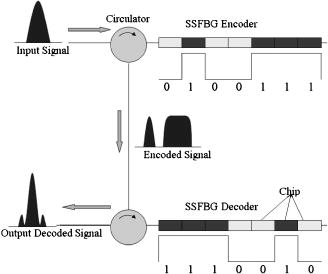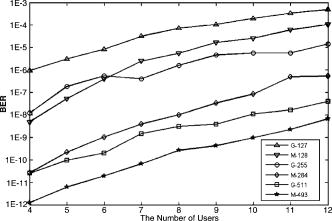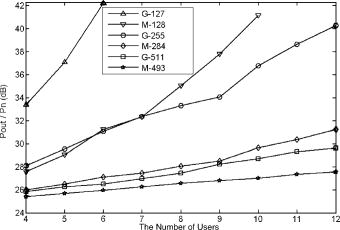|
|
1.IntroductionOptical code division multiple access (OCDMA) technology is getting more and more attractive for its random asynchronous accessibility, simple network management, and high level of security. Recently, several schemes have been proposed for designing the encoders (decoders) in OCDMA systems. Among them, encoders (decoders) fabricated by super structure fiber Bragg grating (SSFBG) technology1 have the advantage of lower multiuser interference (MUI) and low cost, and they may have a promising application. To get higher signal-to-noise ratio (SNR) and enlarge the system’s soft capability simultaneously, the code length of the SSFBG encoder is always increasing from 7/63 (Ref. 1) to 127,2 255,3 up to 511.4 Because these encoders use bipolar code, all of them are coded with a Gold sequence, which has been thoroughly studied. However, from research, we find that this code is not the best choice for SSFBG encoding. In this paper, the code used in SSFBG will be optimized. We will propose a new kind of code [multipolar inserting zeros (MIZ) code] to replace the conventional Gold sequence, then the MUI can be decreased further. 2.SSFBG CodingSSFBG is defined as a standard fiber grating, that is, with a rapidly varying refractive index modulation of uniform amplitude and pitch, onto which an additional, slowly varying refractive index modulation profile has been imposed along its length. For a SSFBG encoder (decoder), the slow varying profile just represents the code sequence (as depicted in Fig. 1) and each code bit correlates with a chip of the fiber Bragg grating (FBG). In unipolar coded SSFBG, the code bit can only be 0 or 1, then only the amplitude of the FBG’s refractive index is modulated; while for bipolar coded SSFBG, the code bit can be 1 or , so only the phase of the FBG’s refractive index is modulated. Because bipolar coded SSFBG can significantly decrease the MUI compared with unipolar coded,1 until now all the work related to SSFBG coding used a Gold sequence, a mature bipolar code. However, as illustrated in Ref. 1, the decoded signal can be regarded as the spread of input signal in time domain by the linear convolution of the encoder (decoder) code sequences; then a Gold sequence may not be the best choice for SSFBG coding because it is designed for a circular convolution judgment system. So we proposed the MIZ code to correspond with SSFBG coding. The code bit in MIZ can be 0 or , so both the amplitude and phase of the FBG’s refractive index can be modulated. 3.Code ConstructionWe first present a simple MIZ example. In Table 1, four sequences constructed with 0, are given. These sequences have the following characteristics: (1) 0 appears in the same position; (2) in each sequence, the bit distance between each two nonzero bits is different; (3) the dot product of each two sequences is 0. In fact, these are the general characteristics of MIZ code. A MIZ code with length and weight can be constructed with the following steps: first, decide which bits should be set as nonzero, so as to satisfy characteristic 2; second, choose an appropriate Hadamard matrix of order and fill the code’s nonzero bits with the matrix’s rows, rows generate sequences, then characteristics 1 and 3 can be satisfied automatically. If the Hadamard matrix is of polar , we named the code as . Then the code in Table 1 can be named as MIZ(2,4,7). Table 1A simple MIZ code.
The two steps above for constructing code can be described as find out the seed sequence, and polarize the seed sequence. The details are given below. 3.1.Find Out the Seed SequenceSeed sequence refers to a sequence constructed of 0’s and 1’s, where the bit distances between each two 1’s are different. Let , when is a prime number or a prime number’s power, based on the theory of cyclic difference sets, the seed sequence can be constructed as follows:
Table 2The minimum length of seed sequence for different q .
Note: When
q=9
,
β
is the root of
x2+x+2=0
in
F3
. When
q=16
,
β
is the root of
x4+x+1=0
in
F2
. When
q=25
,
β
is the root of
x2+x+2=0
in
F5
. When
q=27
,
β
is the root of
x3+2x+1=0
in
F3
. 3.2.Polarize the Seed SequenceThe objective of polarization is to construct a Hadamard matrix of order and polar , and then fill the nonzero bits in the seed sequence with the rows of . It should be noticed that not for any or , can be constructed. Table 3 shows the order and polar of the 27 smaller order Hadamard matrices. Table 3Hadamard matrices’ order and polar.
Their construction methods are illustrated in Refs. 5, 6. Using these matrices, we can polarize the seed sequence whose weight appears in Table 3 as the matrix’s order. 4.Correlation PropertyFrom Sec. 3, it can be found that the self-correlation peak of is since it has nonzero bits. Also because the bit distances between each two nonzero bits are different, its maximum self-correlation wing and cross-correlation peak are both 1. So the ratio of maximum autocorrelation wing to autocorrelation peak and the ratio of cross-correlation peak to autocorrelation peak for are both . On the other hand, as the Gold sequence is designed based on cycle convolution, an analytical expression for its and under linear convolution cannot be obtained and they can only be estimated from numerical calculation. In Table 4, and of the MIZ code and the Gold code with close code length are compared. Table 4The correlation parameters for Gold and MIZ sequence at close code length.
From this table, it can be seen that under close code length, the and of the MIZ code are much smaller than those of the Gold code. So the MIZ coded system will also have a much higher SNR than that coded with Gold. 5.Simulation ResultsTo give a further comparison between MIZ and Gold sequences, a simulation model of direct-sequence OCDMA (DS-OCDMA) system is proposed. For convenience, the dispersive and nonlinear effects in the fiber are ignored. The power loss within the channel is also not considered. We use a random signal that obeys Gaussian distribution to calculate all the noises in the channel, including the shot noise, thermal noise, quantum noise, and other noise sources. Six cases are considered: 127-chips, 255-chips, and 511-chips SSFBG coded by Gold sequence (G-127, G-255, and G-511), 128-chips, 284-chips, and 493-chips SSFBG coded by MIZ code (M-128, M-284, and M-493). The simulation results are given in Fig. 2 and Fig. 3. In Fig. 2, with ( is output power for each user’s optical source, and is the average noise power), the bit error rate (BER) of the system is calculated for different users. It can be seen that for each pair—G-127 and M-128, G-255 and M-284, G-511 and M-493 (because the pulse width of the input signal is limited by the code length, only the sequences with close length in the two kinds of codes have comparability)—the BER in MIZ is much lower than that in Gold, and several decuples of improvement can be achieved. In Fig. 3, the minimum for reaching the BER of with different number of users is given. It can be seen that for each comparable pair, both the output power and power penalty (denoted by the slope of the curves) in MIZ are much lower than that in Gold. From 1 to several decibels power reduction can also be achieved for different numbers of users. 6.ConclusionsWe have proposed the MIZ code for SSFBG coding. With MIZ coded SSFBG in DS-OCDMA systems, the MUI can be significantly decreased compared with that coded by Gold, so a better BER performance can be achieved. Because MIZ code is designed basing on linear convolution, it can also be used for other systems that use linear convolution for signal recognition. ReferencesP. C. Teh,
P. Petropoulos,
M. Ibsen, and
D. J. Richardson,
“Comparitive study of the performance of seven and 63-chip optical code-division multiple-access encoders and decoders based on superstructured fiber Bragg gratings,”
J. Lightwave Technol., 19
(9), 1352
–1365
(2001). https://doi.org/10.1109/50.948283 0733-8724 Google Scholar
X. Wang,
K. Matsushima, and
K. I. Kitayama,
“Demonstration of the improvement of apodized 127-chip SSFBG in coherent time-spreading OCDMA network,”
Google Scholar
P. C. Teh,
M. Ibsen,
J. H. Lee,
P. Petropoulos, and
D. J. Richardson,
“Demonstration of a four-channel WDM/OCDMA system using 255-chip 320-Gchip/s quarternary phase coding gratings,”
IEEE Photonics Technol. Lett., 14
(2), 227
–229
(2002). https://doi.org/10.1109/68.980530 1041-1135 Google Scholar
X. Wang,
K. K. Matsushima,
K. I. Kitayama,
A. Nishiki,
N. Wada, and
F. Kubota,
“High-performance optical code generation and recognition by use of a 511-chip, 640-chip/s phase-shifted superstructured fiber Bragg grating,”
Opt. Lett., 30
(4), 355
–357
(2005). https://doi.org/10.1364/OL.30.000355 0146-9592 Google Scholar
A. S. Hedayat, Orthogonal Arrays Theory and Applications, Springer, New York (1999). Google Scholar
A. T. Bust,
“Generalized Hadamard matrices,”
(1962). Google Scholar
|




